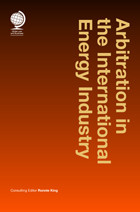
Author(s): Stuart Dutson - Simmons & Simmons, Andy Moody - Baker McKenzie, Neil Newing - Signature Litigation LLP
Publication date: Jan 2019
Format: Hardback
Pages: 298
Price: £125.00
ISBN: 9781787421608
How our eBook platform works
How permanent access, multi-user eBooks work
Add to basket (UK and Europe)Click to buy (USA, rest of world)
Add to basket (UK and Europe)Click to buy (USA, rest of world)
Review for first edition - The book doesn’t just explain what arbitration is and how it works; the authors also give their own practical tips on each issue. The book is therefore an extremely useful and practical read for all practitioners involved in arbitral procedures. We recommend it
Written with the practitioner in mind, the book is logically organised, with a detailed table of contents and index, plus the time-saving feature of useful tips galore, highlighted in boxed shaded sections throughout.
,
This is a good book. It deserves its place among the best arbitration publications in the English law library, and should be of use to other lawyers far beyond these shores.
,
The guide is not only an excellent introduction to international (commercial) arbitration but also a good reference for those interested in the practical aspects of arbitration. The book contains a number of tips, examples and precedents which are included to help the reader obtain a good grasp of each stage of the proceedings.
,
The global increase in cross-border transactions has led to a rising trend in international disputes. International arbitration has become the preferred dispute resolution method, as companies and individuals increasingly favour a neutral international tribunal over foreign domestic courts.
This edition provides a practical guide to international arbitration. Written by leading experts Stuart Dutson from Simmons & Simmons, Andy Moody from Baker McKenzie and Neil Newing from Signature Litigation, this title explains the stages of the arbitration process in a straightforward manner and from a practitioner's perspective. The authors provide guidance on drafting the arbitration agreement, commencing arbitration, selecting the arbitral tribunal, drafting pleadings and evidence, managing oral hearings, liaising with the tribunal throughout the arbitral process and enforcing the final award.
Numerous tips, examples and precedents are included to help the new practitioner or interested student understand each stage of the arbitration proceedings.
The second edition provides an update to take into account the rule changes that have been adopted by arbitral institutions in the six years since the first edition was published, and to include up-to-date guidance on topical issues such as: third party funding in international arbitration; the increase in the number of multi-party arbitrations; procedural trends including the adoption of expedited timetables and guidance around the use of tribunal secretaries; and issues of ethics applicable to counsel and tribunals in cross-border disputes.
















